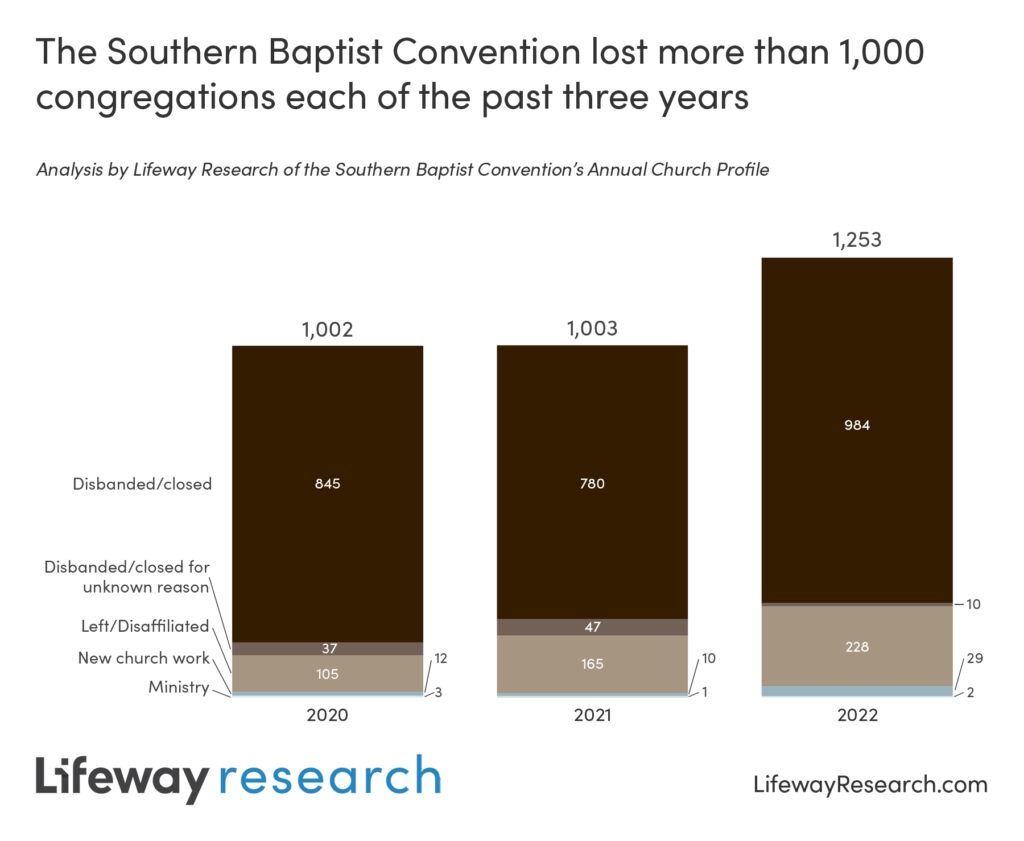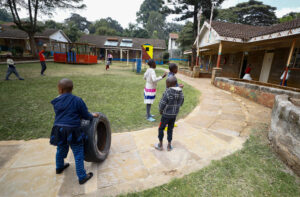
BRENTWOOD, Tenn. (BP) – The Southern Baptist Convention faces not only declining membership but also fewer churches to attract potential new members.
According to Lifeway Research’s analysis of the 2022 Annual Church Profile (ACP) of the Southern Baptist Convention, 1,253 congregations that were part of the Convention in 2021 were no longer connected in 2022. This is the most recent ACP data available. The 2023 report will be released soon.
Among the 50,423 active congregations in the Southern Baptist Convention in 2021, 2 percent disbanded or closed and 0.5 percent left or were disaffiliated from the Convention by the time the 2022 data was compiled.
Some churches were planted to offset that number, but the SBC saw 416 fewer churches and 165 fewer church-type missions associated with the Convention in 2022 than in 2021. The lack of new churches to replace the number of churches closing is a broader issue within U.S. Protestantism. Previous Lifeway Research analysis found approximately 4,500 Protestant churches closed in the U.S. in 2019 while only around 3,000 were started.
“Every week, the national network of Southern Baptist congregations changes,” said Scott McConnell, executive director of Lifeway Research. “New churches are added. Relationships are updated. Churches move, merge, change names and vote to disband. Once each year, we take a snapshot of the current Southern Baptist congregations to report national statistics. Later, analysis between annual lists of congregations reveals more details of these constant changes.”
The primary reason congregations are no longer considered active Southern Baptist congregations is that they cease to exist. Around 4 in 5 of the missing congregations (79 percent) disbanded/closed, leaving Southern Baptists with 984 fewer congregations.
Within that group, 813 (83 percent) closed. Another 136 (14 percent) merged into another Southern Baptist congregation. Fewer became part of a non-Southern Baptist church (17 or 2 percent), never got started (8 or 1 percent) or are now a campus of another church (10 or 1 percent).
Aside from the congregations that disbanded/closed with a reason given, most other previously Southern Baptist congregations either left the Convention or were disaffiliated (228 or 18 percent). Fewer were updated to be classified as a new church work or not yet a church (29 or 2 percent) or existed as a ministry, not a congregation (2 or less than 1 percent). Another 10 (1 percent) disbanded/closed and no reason is known.
“The count of congregations that either left or were disaffiliated is based on whether they were affiliated when the annual dataset was compiled,” McConnell said. “The affiliation is removed if either the congregation or the Southern Baptist Convention informs administrators that it has ended. The goal is to make updates to affiliation as they happen, not to assign responsibility to anyone for the separation.”
Compared to previous years
The number of congregations that disbanded or closed and left or disaffiliated from 2021 to 2022 is higher than the previous two years when 1,003 and 1,002 congregations ceased being part of the SBC.
“Many expected the number of church closings to spike because of the pandemic,” McConnell said. “While temporary closures were widespread, permanent closures did not immediately surge. It was not until 2022 that an increase in disbanded congregations was measured in the SBC.”
In the 2021 analysis of 2020 data, 1,003 churches were considered no longer active Southern Baptist congregations. Among those were 780 that closed or disbanded with a known reason (78 percent), 47 where the reason was unknown (5 percent), 165 that left or were disaffiliated (16 percent), 10 were new church works or not yet a church (1 percent), and one existed as a ministry, not a congregation (less than 1 percent).
Of the 780 with a reason recorded for closing or disbanding, 654 closed (84 percent), 82 merged into another Southern Baptist church (11 percent), 27 became part of a non-Southern Baptist church (3 percent), 11 became a campus of another church (1 percent) and six never got started (1 percent).
Examination of the 2019 data in 2020 revealed 1,002 churches that ceased being part of the SBC, including 845 with a reason recorded for disbanding or closing (84 percent), 37 without a reason (4 percent), 105 that left or were disaffiliated (10 percent), 12 were a new church work (1 percent) and three existed as a ministry, not a congregation (less than 1 percent).
Among those from 2019 to 2020 that disbanded with a given reason, 684 closed (81 percent), 104 merged into another Southern Baptist church (12 percent), 32 merged into a non-Southern Baptist church (4 percent), 15 never got started (2 percent) and 10 became a campus of a new church (1 percent).
“It can be painful for all involved when an active congregation and the convention separate,” McConnell said. “While the number of congregations who left or were disaffiliated doubled in 2022, more than four times as many were removed from the Southern Baptist Convention’s congregation list because the last few remaining members voted to cease to be a congregation.”
For more information, view the complete report or visit LifewayResearch.com.
Methodology
Final ACP congregation files for 2022 that include both churches and church-type missions were compared to 2021. Postmortem analysis was conducted by Lifeway Research to determine what happened to each congregation in the 2021 dataset not found in the 2022 dataset.
The primary sources used for this analysis were:
- The reason codes and notes provided by state conventions when congregations were marked inactive
- Affiliation data in SBCWorkspace for active congregations
There were 1,272 congregations in 2021 not found in the 2022 dataset, with 19 that should not be on this list due to errors in either 2022 or 2021. These include five whose SBCID was corrected, five that should not have been in the 2021 file because they are duplicates of other congregations and nine that should have been active in the 2022 file. The accurate number of congregations in the 2021 dataset not in the 2022 dataset is 1,253.
Special thanks is due to the data administrators and clerks in each state convention who entered this data in SBCWorkspace and provided notes to Lifeway.
















